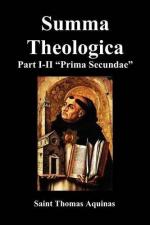Obj. 3: Further, the Apostle seems to distinguish both laws by calling the Old Law “a law of works,” and the New Law “a law of faith” (Rom. 3:27). But the Old Law was also a law of faith, according to Heb. 11:39: “All were [Vulg.: ‘All these being’] approved by the testimony of faith,” which he says of the fathers of the Old Testament. In like manner the New Law is a law of works: since it is written (Matt. 5:44): “Do good to them that hate you”; and (Luke 22:19): “Do this for a commemoration of Me.” Therefore the New Law is not distinct from the Old.
On the contrary, the Apostle says (Heb. 7:12): “The priesthood being translated it is necessary that a translation also be made of the Law.” But the priesthood of the New Testament is distinct from that of the Old, as the Apostle shows in the same place. Therefore the Law is also distinct.
I answer that, As stated above (Q. 90, A. 2; Q. 91, A. 4), every law ordains human conduct to some end. Now things ordained to an end may be divided in two ways, considered from the point of view of the end. First, through being ordained to different ends: and this difference will be specific, especially if such ends are proximate. Secondly, by reason of being closely or remotely connected with the end. Thus it is clear that movements differ in species through being directed to different terms: while according as one part of a movement is nearer to the term than another part, the difference of perfect and imperfect movement is assessed.
Accordingly then two laws may be distinguished from one another in two ways. First, through being altogether diverse, from the fact that they are ordained to diverse ends: thus a state-law ordained to democratic government, would differ specifically from a law ordained to government by the aristocracy. Secondly, two laws may be distinguished from one another, through one of them being more closely connected with the end, and the other more remotely: thus in one and the same state there is one law enjoined on men of mature age, who can forthwith accomplish that which pertains to the common good; and another law regulating the education of children who need to be taught how they are to achieve manly deeds later on.
We must therefore say that, according to the first way, the New Law is not distinct from the Old Law: because they both have the same end, namely, man’s subjection to God; and there is but one God of the New and of the Old Testament, according to Rom. 3:30: “It is one God that justifieth circumcision by faith, and uncircumcision through faith.” According to the second way, the New Law is distinct from the Old Law: because the Old Law is like a pedagogue of children, as the Apostle says (Gal. 3:24), whereas the New Law is the law of perfection, since it is the law of charity, of which the Apostle says (Col. 3:14) that it is “the bond of perfection.”
Reply Obj. 1: The unity of faith under both Testaments witnesses to the unity of end: for it has been stated above (Q. 62, A. 2) that the object of the theological virtues, among which is faith, is the last end. Yet faith had a different state in the Old and in the New Law: since what they believed as future, we believe as fact.




